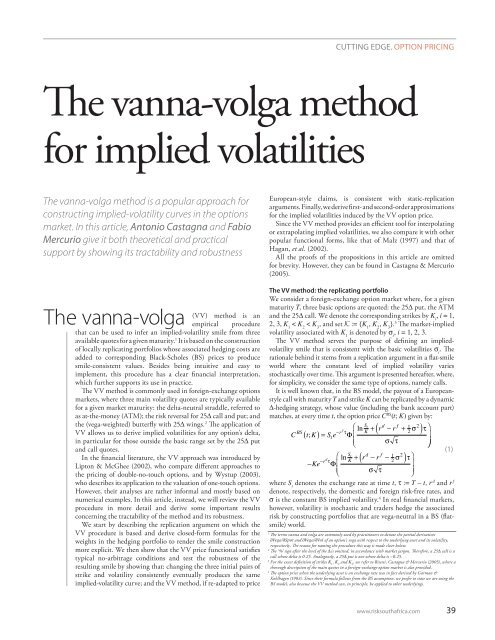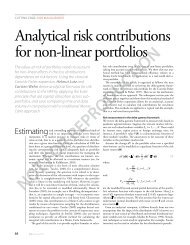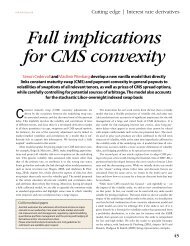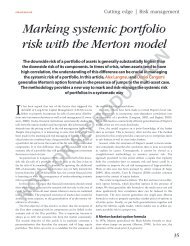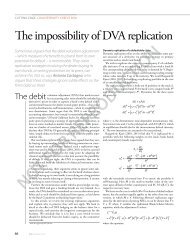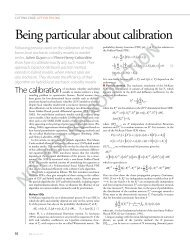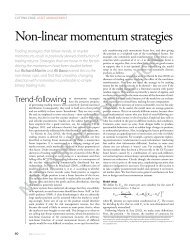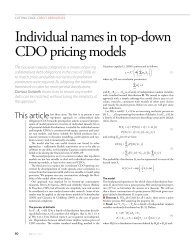The vanna-volga method for implied volatilities (PDF - Risk.net
The vanna-volga method for implied volatilities (PDF - Risk.net
The vanna-volga method for implied volatilities (PDF - Risk.net
You also want an ePaper? Increase the reach of your titles
YUMPU automatically turns print PDFs into web optimized ePapers that Google loves.
<strong>The</strong> <strong>vanna</strong>-<strong>volga</strong> <strong>method</strong><br />
<strong>for</strong> <strong>implied</strong> <strong>volatilities</strong><br />
<strong>The</strong> <strong>vanna</strong>-<strong>volga</strong> <strong>method</strong> is a popular approach <strong>for</strong><br />
constructing <strong>implied</strong>-volatility curves in the options<br />
market. In this article, Antonio Castagna and Fabio<br />
Mercurio give it both theoretical and practical<br />
support by showing its tractability and robustness<br />
<strong>The</strong> <strong>vanna</strong>-<strong>volga</strong><br />
(VV) <strong>method</strong> is an<br />
empirical procedure<br />
that can be used to infer an <strong>implied</strong>-volatility smile from three<br />
available quotes <strong>for</strong> a given maturity. 1 It is based on the construction<br />
of locally replicating portfolios whose associated hedging costs are<br />
added to corresponding Black-Scholes (BS) prices to produce<br />
smile-consistent values. Besides being intuitive and easy to<br />
implement, this procedure has a clear financial interpretation,<br />
which further supports its use in practice.<br />
<strong>The</strong> VV <strong>method</strong> is commonly used in <strong>for</strong>eign-exchange options<br />
markets, where three main volatility quotes are typically available<br />
<strong>for</strong> a given market maturity: the delta-neutral straddle, referred to<br />
as at-the-money (ATM); the risk reversal <strong>for</strong> 25D call and put; and<br />
the (vega-weighted) butterfly with 25D wings. 2 <strong>The</strong> application of<br />
VV allows us to derive <strong>implied</strong> <strong>volatilities</strong> <strong>for</strong> any option’s delta,<br />
in particular <strong>for</strong> those outside the basic range set by the 25D put<br />
and call quotes.<br />
In the financial literature, the VV approach was introduced by<br />
Lipton & McGhee (2002), who compare different approaches to<br />
the pricing of double-no-touch options, and by Wystup (2003),<br />
who describes its application to the valuation of one-touch options.<br />
However, their analyses are rather in<strong>for</strong>mal and mostly based on<br />
numerical examples. In this article, instead, we will review the VV<br />
procedure in more detail and derive some important results<br />
concerning the tractability of the <strong>method</strong> and its robustness.<br />
We start by describing the replication argument on which the<br />
VV procedure is based and derive closed-<strong>for</strong>m <strong>for</strong>mulas <strong>for</strong> the<br />
weights in the hedging portfolio to render the smile construction<br />
more explicit. We then show that the VV price functional satisfies<br />
typical no-arbitrage conditions and test the robustness of the<br />
resulting smile by showing that: changing the three initial pairs of<br />
strike and volatility consistently eventually produces the same<br />
<strong>implied</strong>-volatility curve; and the VV <strong>method</strong>, if re-adapted to price<br />
European-style claims, is consistent with static-replication<br />
arguments. Finally, we derive first- and second-order approximations<br />
<strong>for</strong> the <strong>implied</strong> <strong>volatilities</strong> induced by the VV option price.<br />
Since the VV <strong>method</strong> provides an efficient tool <strong>for</strong> interpolating<br />
or extrapolating <strong>implied</strong> <strong>volatilities</strong>, we also compare it with other<br />
popular functional <strong>for</strong>ms, like that of Malz (1997) and that of<br />
Hagan, et al. (2002).<br />
All the proofs of the propositions in this article are omitted<br />
<strong>for</strong> brevity. However, they can be found in Castagna & Mercurio<br />
(2005).<br />
<strong>The</strong> VV <strong>method</strong>: the replicating portfolio<br />
We consider a <strong>for</strong>eign-exchange option market where, <strong>for</strong> a given<br />
maturity T, three basic options are quoted: the 25D put, the ATM<br />
and the 25D call. We denote the corresponding strikes by K i , i = 1,<br />
2, 3, K 1 < K 2 < K 3 , and set K := {K 1 , K 2 , K 3 }. 3 <strong>The</strong> market-<strong>implied</strong><br />
volatility associated with K 1 is denoted by s i , i = 1, 2, 3.<br />
<strong>The</strong> VV <strong>method</strong> serves the purpose of defining an <strong>implied</strong>volatility<br />
smile that is consistent with the basic <strong>volatilities</strong> s i . <strong>The</strong><br />
rationale behind it stems from a replication argument in a flat-smile<br />
world where the constant level of <strong>implied</strong> volatility varies<br />
stochastically over time. This argument is presented hereafter, where,<br />
<strong>for</strong> simplicity, we consider the same type of options, namely calls.<br />
It is well known that, in the BS model, the payout of a Europeanstyle<br />
call with maturity T and strike K can be replicated by a dynamic<br />
D-hedging strategy, whose value (including the bank account part)<br />
matches, at every time t, the option price C BS (t; K) given by:<br />
BS<br />
( ) =<br />
C t; K S e<br />
−Ke<br />
t<br />
d<br />
−r<br />
t<br />
cutting edge. option pricing<br />
f<br />
−r t<br />
⎛ ln<br />
Φ ⎜<br />
⎝<br />
⎜<br />
St<br />
K<br />
d f 1 2<br />
( 2 )<br />
+ r − r +<br />
s t<br />
( )<br />
⎛ St<br />
d f<br />
+ − −<br />
⎞<br />
K r r s t<br />
Φ ⎜<br />
⎟<br />
⎝<br />
⎜<br />
s t<br />
⎠<br />
⎟<br />
ln 1 2<br />
2<br />
s t ⎞<br />
⎟<br />
⎠<br />
⎟<br />
where S t denotes the exchange rate at time t, t := T – t, r d and r f<br />
denote, respectively, the domestic and <strong>for</strong>eign risk-free rates, and<br />
s is the constant BS <strong>implied</strong> volatility. 4 In real financial markets,<br />
however, volatility is stochastic and traders hedge the associated<br />
risk by constructing portfolios that are vega-neutral in a BS (flatsmile)<br />
world.<br />
1 <strong>The</strong> terms <strong>vanna</strong> and <strong>volga</strong> are commonly used by practitioners to denote the partial derivatives<br />
∂Vega/∂Spot and ∂Vega/∂Vol of an option’s vega with respect to the underlying asset and its volatility,<br />
respectively. <strong>The</strong> reason <strong>for</strong> naming the procedure this way is made clear below.<br />
2 <strong>The</strong> ‘%’ sign after the level of the D is omitted, in accordance with market jargon. <strong>The</strong>re<strong>for</strong>e, a 25D call is a<br />
call whose delta is 0.25. Analogously, a 25D put is one whose delta is –0.25.<br />
3 For the exact definition of strikes K1 , K 2 and K 3 , we refer to Bisesti, Castagna & Mercurio (2005), where a<br />
thorough description of the main quotes in a <strong>for</strong>eign-exchange option market is also provided.<br />
4 <strong>The</strong> option price when the underlying asset is an exchange rate was in fact derived by Garman &<br />
Kohlhagen (1983). Since their <strong>for</strong>mula follows from the BS assumption, we prefer to state we are using the<br />
BS model, also because the VV <strong>method</strong> can, in principle, be applied to other underlyings.<br />
(1)<br />
www.risksouthafrica.com 39
cutting edge. option pricing<br />
Maintaining the assumption of flat but stochastic <strong>implied</strong><br />
<strong>volatilities</strong>, the presence of three basic options in the market makes<br />
it possible to build a portfolio that zeroes out partial derivatives up<br />
to the second order. In fact, denoting respectively by D and x the<br />
t i<br />
units of the underlying asset and options with strikes K held at<br />
i<br />
BS BS time t and setting C (t) = C (t; Ki ), under diffusion dynamics <strong>for</strong><br />
i<br />
both S and s = s , we have by Itô’s lemma:<br />
t t<br />
dC BS t; K<br />
40 risk South Africa Autumn 2007<br />
( ) − ∆t dSt − ∑ xidC i<br />
( )<br />
= ∂C BS ⎡ t; K<br />
⎢<br />
⎣⎢<br />
∂t<br />
( )<br />
+ ∂C BS ⎡ t; K<br />
⎢<br />
⎣⎢<br />
∂S<br />
+ 1 ⎡<br />
⎢<br />
2 ⎣⎢<br />
+ 1 ⎡<br />
⎢<br />
2 ⎣⎢<br />
( )<br />
+ ∂C BS ⎡ t; K<br />
⎢<br />
⎣⎢<br />
∂σ<br />
⎡<br />
⎢<br />
⎣⎢<br />
( )<br />
∂S 2<br />
∂ 2 C BS t; K<br />
( )<br />
∂σ 2<br />
∂ 2 C BS t; K<br />
( )<br />
+ ∂2 C BS t; K<br />
∂S∂σ<br />
3<br />
∑<br />
− x i<br />
i=1<br />
3<br />
∑<br />
3<br />
i=1<br />
− ∆ t − x i<br />
3<br />
∑<br />
i=1<br />
− x i<br />
i=1<br />
3<br />
∑<br />
− x i<br />
i=1<br />
3<br />
∑<br />
− x i<br />
i=1<br />
3<br />
∑<br />
− x i<br />
i=1<br />
( )<br />
BS<br />
∂Ci t<br />
∂t<br />
( )<br />
BS t<br />
BS<br />
∂Ci t<br />
∂S<br />
( )<br />
BS<br />
∂Ci t<br />
∂σ<br />
⎤<br />
⎥ dt<br />
⎦⎥<br />
( )<br />
⎤<br />
⎥<br />
⎦⎥<br />
( )<br />
∂ 2 BS<br />
Ci t<br />
∂S 2<br />
( )<br />
∂ 2 BS<br />
Ci t<br />
∂σ 2<br />
( )<br />
∂ 2 BS<br />
Ci t<br />
∂S∂σ<br />
⎤<br />
⎥<br />
⎦⎥<br />
dσ t<br />
⎤<br />
⎥<br />
⎦⎥<br />
⎤<br />
⎥<br />
⎦⎥<br />
dS t<br />
( ) 2<br />
dS t<br />
( ) 2<br />
dσ t<br />
⎤<br />
⎥ dSt dσ t<br />
⎦⎥<br />
Choosing D t and x i so as to zero out the coefficients of dS t , ds t ,<br />
(ds t ) 2 and dS t ds t , 5 the portfolio comprises a long position in the<br />
call with strike K, and short positions in x i calls with strike K i and<br />
short the amount D t of the underlying, and is locally risk-free at<br />
time t, in that no stochastic terms are involved in its differential 6 :<br />
dC BS t; K<br />
= r d C BS ⎡<br />
⎢ t; K<br />
⎣<br />
( ) − ∆t dSt − ∑ xidC i<br />
3<br />
i=1<br />
( ) − ∆t St − ∑ xiC i<br />
3<br />
i=1<br />
( )<br />
BS t<br />
( )<br />
BS t<br />
⎤<br />
⎥<br />
⎦<br />
dt<br />
<strong>The</strong>re<strong>for</strong>e, when volatility is stochastic and options are valued<br />
with the BS <strong>for</strong>mula, we can still have a (locally) perfect hedge,<br />
provided that we hold suitable amounts of three more options to<br />
rule out the model risk. (<strong>The</strong> hedging strategy is irrespective of<br />
the true asset and volatility dynamics, under the assumption of<br />
no jumps.)<br />
n Remark 1. <strong>The</strong> validity of the previous replication argument<br />
may be questioned because no stochastic-volatility model can<br />
produce <strong>implied</strong> <strong>volatilities</strong> that are flat and stochastic at the same<br />
time. <strong>The</strong> simultaneous presence of these features – though<br />
inconsistent from a theoretical point of view – can, however, be<br />
justified on empirical grounds. In fact, the practical advantages of<br />
the BS paradigm are so clear that many <strong>for</strong>eign-exchange option<br />
traders run their books by revaluing and hedging according to a<br />
BS flat-smile model, with the ATM volatility being continuously<br />
updated to the actual market level. 7<br />
<strong>The</strong> first step in the VV procedure is the construction of the<br />
above hedging portfolio, whose weights x i are explicitly calculated<br />
in the following section.<br />
(2)<br />
(3)<br />
Calculating the VV weights<br />
We assume hereafter that the constant BS volatility is the ATM<br />
one, thus setting s = s 2 (= s ATM ). We also assume that t = 0,<br />
dropping accordingly the argument t in the call prices. From (2),<br />
we see that the weights x 1 = x 1 (K), x 2 = x 2 (K) and x 3 = x 3 (K), <strong>for</strong><br />
which the resulting portfolio of European-style calls with<br />
maturity T and strikes K 1 , K 2 and K 3 has the same vega, ∂Vega/<br />
∂Vol and ∂Vega/∂Spot as the call with strike K, 8 can be found by<br />
solving the following system:<br />
∂<br />
( ) = ( )<br />
∂<br />
∂<br />
C<br />
K ∑ x K<br />
∂<br />
C<br />
i<br />
s s<br />
2<br />
∂ C<br />
∂s<br />
2<br />
BS<br />
BS<br />
2<br />
∂ C<br />
∂ ∂<br />
BS<br />
3<br />
i=<br />
1<br />
3<br />
( ) = ∑<br />
i=<br />
1<br />
s S0 i=<br />
1<br />
BS<br />
C<br />
K xi<br />
( K ) ∂<br />
∂s<br />
3<br />
BS<br />
( K )<br />
i<br />
( K )<br />
∂ C<br />
( K ) = ∑ xi ( K )<br />
∂ ∂S<br />
K<br />
s<br />
2<br />
2<br />
2<br />
BS<br />
0<br />
i<br />
( )<br />
Denoting by V(K) the vega of a European-style option with<br />
maturity T and strike K:<br />
BS<br />
∂C<br />
V ( K ) =<br />
∂σ K<br />
( ) = S 0 e− r f T T ϕ d1 K<br />
2<br />
( σ )T<br />
d1 ( K ) = ln S0 K + r d − r f + 1<br />
2<br />
σ T<br />
i<br />
( ( ) )<br />
where j(x) = Φ′(x) is the normal density function, and calculating<br />
the second-order derivatives:<br />
2<br />
BS<br />
( )<br />
∂ C<br />
2<br />
∂<br />
K<br />
( K ) = d1 K d2 K<br />
2<br />
∂ C<br />
( ) = −<br />
∂ ∂S<br />
K<br />
s<br />
V<br />
s<br />
BS V ( K )<br />
d2 ( K )<br />
s S s T<br />
0<br />
( ) = ( ) −<br />
d K d K s T<br />
2 1<br />
we can prove the following.<br />
0<br />
( ) ( )<br />
n Proposition 1. <strong>The</strong> system (4) admits a unique solution, which<br />
is given by:<br />
x K<br />
1<br />
x K<br />
2<br />
( ) =<br />
( ) =<br />
( ) =<br />
x K<br />
3<br />
( )<br />
( )<br />
V K<br />
V K<br />
1<br />
( )<br />
( )<br />
V K<br />
V K<br />
2<br />
( )<br />
( )<br />
V K<br />
V K<br />
3<br />
K2<br />
K<br />
K3<br />
K<br />
K2<br />
K1<br />
K3<br />
K1<br />
ln ln<br />
ln ln<br />
ln ln<br />
K<br />
K1<br />
K2<br />
K1<br />
ln ln<br />
ln ln<br />
K3<br />
K<br />
K3<br />
K2<br />
K<br />
K1<br />
K<br />
K2<br />
K3<br />
K1<br />
K3<br />
K2<br />
ln ln<br />
In particular, if K = K j then x i (K) = 1 <strong>for</strong> i = j and zero<br />
otherwise.<br />
<strong>The</strong> VV option price<br />
We can now proceed to the definition of an option price that is<br />
consistent with the market prices of the basic options.<br />
<strong>The</strong> above replication argument shows that a portfolio<br />
5 <strong>The</strong> coefficient of (dSt ) 2 will be zeroed accordingly, due to the relation linking an option’s gamma and<br />
vega in the BS world.<br />
6 We also use the BS partial differential equation.<br />
7 ‘Continuously’ typically means a daily or slightly more frequent update.<br />
8 This explains the name assigned to the smile-construction procedure, given the meaning of the terms<br />
<strong>vanna</strong> and <strong>volga</strong>.<br />
(4)<br />
(5)<br />
(6)
Data source: Bloomberg<br />
1 Implied <strong>volatilities</strong> plotted against strikes and put deltas (in absolute value), calibrated to the three basic euro/<br />
dollar quotes and compared with the 10D (put and call) <strong>volatilities</strong><br />
Implied volatility<br />
0.125<br />
0.120<br />
0.115<br />
0.110<br />
0.105<br />
0.100<br />
0.095<br />
comprising x i (K) units of the option with strike K i (and D 0 units<br />
of the underlying asset) gives a local perfect hedge in a BS world.<br />
<strong>The</strong> hedging strategy, however, has to be implemented at<br />
prevailing market prices, which generates an extra cost with<br />
respect to the BS value of the options portfolio. Such a cost has to<br />
be added to the BS price (1), with t = 0, to produce an arbitragefree<br />
price that is consistent with the quoted option prices C MKT (K 1 ),<br />
C MKT (K 2 ) and C MKT (K 3 ).<br />
In fact, in case of a short maturity – that is, <strong>for</strong> a small T – (3)<br />
can be approximated as:<br />
so that setting:<br />
we have:<br />
( ST − K ) + − C BS ( K ) − ∆ 0 [ ST − S0 ]<br />
3<br />
( ) + − C BS ( Ki )<br />
−∑ x ⎡<br />
i ST − Ki ⎣<br />
i=1<br />
≈ r d C BS ⎡<br />
⎢ K<br />
⎣<br />
⎤<br />
⎦<br />
( ) − ∆ 0S0 − xiC BS 3<br />
∑<br />
i=1<br />
Ki 3<br />
( )<br />
⎤<br />
⎥<br />
⎦<br />
T<br />
( ) = ( ) + ∑ ( ) ( ) − ( i )<br />
i=<br />
1<br />
BS<br />
C K C K x K ⎡ MKT<br />
BS<br />
i ⎣<br />
C Ki C K<br />
( ST − K ) + ≈ C ( K ) + ∆ 0 [ ST − S0 ]<br />
3<br />
( ) + − C MKT ( Ki )<br />
+ ∑ x ⎡<br />
i ST − Ki ⎣<br />
i=1<br />
+ r d ⎡<br />
⎢C<br />
K<br />
⎣<br />
Euro/dollar quotes<br />
10∆ (put and call) <strong>volatilities</strong><br />
0.090<br />
1.05 1.10 1.15 1.20 1.25 1.30 1.35<br />
Strike<br />
( ) − ∆ 0S0 − xiC MKT 3<br />
∑<br />
i=1<br />
Ki ⎤<br />
⎦<br />
( )<br />
Vanna-<strong>volga</strong><br />
Malz<br />
SABR<br />
⎤<br />
⎥<br />
⎦<br />
T<br />
<strong>The</strong>re<strong>for</strong>e, when actual market prices are considered, the option<br />
payout (S T – K) + can still be replicated by buying D 0 units of the<br />
underlying asset and x i options with strike K i (investing the<br />
resulting cash at rate r d ), provided one starts from the initial<br />
endowment C(K).<br />
<strong>The</strong> quantity C(K) in (7) is thus defined as the VV option’s<br />
premium, implicitly assuming that the replication error is also<br />
negligible <strong>for</strong> longer maturities. Such a premium equals the BS<br />
price C BS (K) plus the cost difference of the hedging portfolio<br />
induced by the market-<strong>implied</strong> <strong>volatilities</strong> with respect to the<br />
constant volatility s. Since we set s = s 2 , the market volatility <strong>for</strong><br />
⎤<br />
⎦<br />
(7)<br />
Implied volatility<br />
0.125<br />
0.120<br />
0.115<br />
0.110<br />
0.105<br />
0.100<br />
0.095<br />
0.090<br />
0 0.1 0.2 0.3 0.4 0.5 0.6 0.7 0.8 0.9 1.0<br />
strike K 2 , (7) can be simplified to:<br />
( ) = ( ) + ( ) ( ) − ( )<br />
C K<br />
BS<br />
C K x1 K ⎡ MKT<br />
⎣<br />
C K1 BS<br />
C K1<br />
⎤<br />
⎦<br />
+ x3 ( K ) ⎡ MKT BS<br />
⎣<br />
C ( K3 ) − C ( K3<br />
) ⎤<br />
⎦<br />
n Remark 2. Expressing the system (4) in the <strong>for</strong>m b = Ax and<br />
setting c = (c 1 , c 2 , c 3 )′, where c i := C MKT (K i ) – C BS (K i ), and y = (y 1 ,<br />
y 2 , y 3 )′ := (A′) –1 c, we can also write:<br />
C K C K y C<br />
BS<br />
∂<br />
( ) = ( ) + 1<br />
∂s<br />
2<br />
∂ C<br />
+ y2<br />
∂s<br />
BS<br />
2<br />
( ) +<br />
K y<br />
3<br />
2<br />
BS<br />
BS<br />
( K )<br />
∂ C<br />
S K<br />
∂s∂ 0<br />
( )<br />
<strong>The</strong> difference between the VV and BS prices can thus be<br />
interpreted as the sum of the option’s vega, ∂Vega/∂Vol and<br />
∂Vega/∂Spot, weighted by their respective hedging cost y. 9 Besides<br />
being quite intuitive, this representation also has the advantage<br />
that the weights y are independent of the strike K and, as such,<br />
can be calculated once <strong>for</strong> all. However, we prefer to stick to the<br />
definition (7), since it allows an easier derivation of our<br />
approximations below.<br />
<strong>The</strong> VV option price has several interesting features that we<br />
analyse in the following.<br />
When K = K j , C(K j ) = C MKT (K j ), since x i (K) = 1 <strong>for</strong> i = j and<br />
zero otherwise. <strong>The</strong>re<strong>for</strong>e, (7) defines a rule <strong>for</strong> either interpolating<br />
or extrapolating prices from the three option quotes C MKT (K 1 ),<br />
C MKT (K 2 ) and C MKT (K 3 ).<br />
<strong>The</strong> option price C(K), as a function of the strike K, is twice<br />
differentiable and satisfies the following (no-arbitrage) conditions:<br />
lim C K S e and lim C K<br />
lim<br />
Euro/dollar quotes<br />
10∆ (put and call) <strong>volatilities</strong><br />
Put delta<br />
Vanna-<strong>volga</strong><br />
Malz<br />
SABR<br />
+<br />
K →0<br />
( ) = 0<br />
f<br />
−r<br />
T<br />
K →+∞ ( ) = 0<br />
d<br />
dC<br />
−r<br />
T<br />
+<br />
K →0<br />
dK ( K ) = − e dC<br />
K →+∞ K dK ( K ) =<br />
and lim 0<br />
<strong>The</strong>se properties, which are trivially satisfied by C BS (K), follow<br />
from the fact that, <strong>for</strong> each i, both x i (K) and dx i (K)/dK go to zero<br />
<strong>for</strong> K → 0 + or K → +∞.<br />
To avoid arbitrage opportunities, the option price C(K) should<br />
9 <strong>The</strong> authors thank one of the referees <strong>for</strong> suggesting this alternative <strong>for</strong>mulation.<br />
www.risksouthafrica.com 41
cutting edge.option pricing<br />
also be a convex function of the strike K, that is, (d 2 C)/(dK 2 )(K) ><br />
0 <strong>for</strong> each K > 0. This property, which is not true in general, 10<br />
holds <strong>for</strong> typical market parameters, so that (7) leads to prices<br />
that are arbitrage-free in practice.<br />
<strong>The</strong> VV <strong>implied</strong>-volatility curve K → ς(K) can be obtained by<br />
inverting (7), <strong>for</strong> each considered K, through the BS <strong>for</strong>mula. An<br />
example of such a curve is shown in figure 1. Since, by<br />
construction, ς(K i ) = s i , the function ς(K) yields an interpolationextrapolation<br />
tool <strong>for</strong> the market-<strong>implied</strong> <strong>volatilities</strong>.<br />
Comparison with other interpolation rules<br />
Contrary to other interpolation schemes proposed in the financial<br />
literature, the VV pricing <strong>for</strong>mula (7) has several advantages. It<br />
has a clear financial rationale supporting it, based on the hedging<br />
argument leading to its definition; it allows <strong>for</strong> an automatic<br />
calibration to the main volatility data, being an explicit function<br />
of s 1 , s 2 , s 3 ; and it can be extended to any European-style<br />
derivative (see the second consistency result, page 43). To our<br />
knowledge, no other functional <strong>for</strong>m enjoys the same features.<br />
Compared, <strong>for</strong> example, with the second-order polynomial<br />
function (in D) proposed by Malz (1997), the interpolation (7)<br />
equally perfectly fits the three points provided, but, in accordance<br />
with typical market quotes, boosts the volatility value both <strong>for</strong> low-<br />
and high-put deltas. A graphical comparison, based on market<br />
data, between the two functional <strong>for</strong>ms is presented in figure 1,<br />
where their difference at extreme strikes is clearly highlighted.<br />
<strong>The</strong> interpolation (7) also yields a very good approximation of<br />
the smile induced, after calibration to strikes K i , by the most<br />
renowned stochastic-volatility models in the financial literature,<br />
especially within the range [K 1 , K 3 ]. This is not surprising, since<br />
the three strikes provide in<strong>for</strong>mation on the second, third and<br />
fourth moments of the marginal distribution of the underlying<br />
asset, so that models agreeing on these three points are likely to<br />
produce very similar smiles. As a confirmation of this statement,<br />
in figure 1, we also consider the example of the stochastic alpha<br />
beta rho (SABR) functional <strong>for</strong>m of Hagan, et al. (2002), which<br />
has become a standard in the market as far as the modelling of<br />
<strong>implied</strong> <strong>volatilities</strong> is concerned. <strong>The</strong> SABR and VV curves tend<br />
42 risk South Africa Autumn 2007<br />
������������<br />
���������<br />
����������<br />
A. discount factors: July 1, 2005<br />
expiry dollar euro<br />
3M: october 3, 2005 0.9902752 0.9945049<br />
B. Strikes and <strong>volatilities</strong> corresponding to the three<br />
main deltas: July 1, 2005<br />
delta Strike Volatility<br />
25d put 1.1720 9.79%<br />
At-the-money 1.2115 9.375%<br />
25d call 1.2504 9.29%<br />
to agree quite well in the range set by the two 10D options (in the<br />
given example they almost overlap), typically departing from each<br />
other only <strong>for</strong> illiquid strikes. <strong>The</strong> advantage of using the VV<br />
interpolation is that no calibration procedure is involved, since<br />
s 1 , s 2 , s 3 are direct inputs of (7).<br />
Figure 1 compares the volatility smiles yielded by the VV price<br />
(7), the Malz (1997) quadratic interpolation and the SABR<br />
functional <strong>for</strong>m 11 , plotting the respective <strong>implied</strong> <strong>volatilities</strong> both<br />
against strikes and put deltas. <strong>The</strong> three plots are obtained after<br />
calibration to the three basic quotes s 1 , s 2 , s 3 , using the following<br />
euro/dollar data as of July 1, 2005 (provided by Bloomberg): T =<br />
3M, 12 S 0 = 1.205, s 1 = 9.79%, s 2 = 9.375%, s 3 = 9.29%, K 1 =<br />
1.1720, K 2 = 1.2115 and K 3 = 1.2504 (see also tables A and B).<br />
Once the three functional <strong>for</strong>ms are calibrated to the liquid quotes<br />
s 1 , s 2 , s 3 , one may then compare their values at extreme strikes with<br />
the corresponding quotes that may be provided by brokers or<br />
market-makers. To this end, in figure 1, we also report the <strong>implied</strong><br />
<strong>volatilities</strong> of the 10D put and call options (respectively, equal to<br />
10.46% and 9.49%, again provided by Bloomberg) to show that the<br />
Malz (1997) quadratic function is typically not consistent with the<br />
quotes <strong>for</strong> strikes outside the basic interval [K 1 , K 3 ].<br />
10 One can actually find cases where the inequality is violated <strong>for</strong> some strike K.<br />
11 We fix the SABR b parameter to 0.6. Other values of b produce, anyway, quite similar calibrated<br />
<strong>volatilities</strong>.<br />
12 To be precise, on that date the three-month expiry counted 94 days.<br />
���������������<br />
���������<br />
�������<br />
��������<br />
Untitled-1 1 5/1/07 12:42:24
Data source: Bloomberg<br />
2 Euro/dollar <strong>implied</strong> <strong>volatilities</strong> and their approximations plotted against strikes and put deltas (in absolute value)<br />
Implied volatility<br />
0.135<br />
0.130<br />
0.125<br />
0.120<br />
0.115<br />
0.110<br />
0.105<br />
0.100<br />
0.095<br />
Two consistency results <strong>for</strong> the VV price<br />
We now state two important consistency results that hold<br />
<strong>for</strong> the option price (7) and that give further support to the<br />
VV procedure.<br />
<strong>The</strong> first result is as follows. One may wonder what happens if<br />
we apply the VV curve construction <strong>method</strong> when starting from<br />
three other strikes whose associated prices coincide with those<br />
coming from (7). Clearly, <strong>for</strong> the procedure to be robust, we<br />
would want the two curves to exactly coincide. This is indeed<br />
the case.<br />
In fact, consider a new set of strikes H := {H 1 , H 2 , H 3 }, <strong>for</strong><br />
which we set:<br />
( ) = ( )<br />
H K<br />
i i<br />
C H C H<br />
3<br />
∑<br />
j = 1<br />
BS<br />
C H x H ⎡ MKT<br />
i j i ⎣<br />
C K j C<br />
= ( ) + ( ) ( ) −<br />
Vanna-<strong>volga</strong> smile<br />
First-order approximation<br />
Second-order approximation<br />
0.090<br />
1.05 1.10 1.15 1.20 1.25 1.30 1.35<br />
Strike<br />
BS<br />
( K j )<br />
where the superscripts H and K highlight the set of strikes the<br />
pricing procedure is based on, and weights x j are obtained from K<br />
with (6). For a generic strike K, denoting by x i (K; H) the weights<br />
<strong>for</strong> K that are derived starting from the set H, the option price<br />
associated to H is defined, analogously to (7), by:<br />
( ) = (<br />
3<br />
) + ∑<br />
j = 1<br />
( ) ( ) − ( j )<br />
H BS<br />
H<br />
BS<br />
C K C K x j K; H ⎡<br />
⎣<br />
C H j C H<br />
where the second term in the sum is now not necessarily zero<br />
since H 2 is, in general, different from K 2 . <strong>The</strong> following proposition<br />
states the desired consistency result.<br />
n Proposition 2. <strong>The</strong> call prices based on H coincide with those<br />
based on K, namely, <strong>for</strong> each strike K:<br />
⎤<br />
⎦<br />
⎤<br />
⎦<br />
(8)<br />
H K<br />
C ( K ) = C ( K ) (9)<br />
A second consistency result that can be proven <strong>for</strong> the option<br />
price (7) concerns the pricing of European-style derivatives and<br />
their static replication. To this end, assume that h(x) is a real<br />
function that is defined <strong>for</strong> x ∈ [0, ∞), is well behaved at infinity<br />
and is twice differentiable. Given the simple claim with payout<br />
h(S T ) at time T, we denote by V its price at time zero, when taking<br />
into account the whole smile of the underlying at time T. By Carr<br />
& Madan (1998), we have:<br />
Implied volatility<br />
0.135<br />
0.130<br />
0.125<br />
0.120<br />
0.115<br />
0.110<br />
0.105<br />
0.100<br />
0.095<br />
0.090<br />
0 0.1 0.2 0.3 0.4 0.5 0.6 0.7 0.8 0.9 1.0<br />
d f<br />
−r T − r T<br />
+∞<br />
= ( ) + 0 ′ ( ) + ∫ ′′ ( ) ( )<br />
0<br />
V e h 0 S e h 0 h K C K dK<br />
<strong>The</strong> same reasoning adopted above (see ‘<strong>The</strong> VV <strong>method</strong>: the<br />
replicating portfolio’) with regard to the local hedge of the call<br />
with strike K can also be applied to the general payout h(S T ). We<br />
can thus construct a portfolio of European-style calls with<br />
maturity T and strikes K 1 , K 2 and K 3 , such that the portfolio has<br />
the same vega, ∂Vega/∂Vol and ∂Vega/∂Spot as the given<br />
derivative. Denoting by V BS the claim price under the BS model,<br />
this is achieved by finding the corresponding portfolio weights x h<br />
1 ,<br />
xh and xh,<br />
which are always unique (see Proposition 1). We can<br />
2 3<br />
then define a new (smile-consistent) price <strong>for</strong> our derivative as:<br />
3<br />
Put delta<br />
= + ∑ ( ) − ( i )<br />
i=<br />
1<br />
BS h<br />
V V x ⎡ MKT<br />
BS<br />
i ⎣<br />
C Ki C K<br />
⎤<br />
⎦<br />
(10)<br />
which is the obvious generalisation of (7). Our second consistency<br />
result is stated in the following.<br />
n Proposition 3. <strong>The</strong> claim price that is consistent with the<br />
option prices (7) is equal to the claim price that is obtained by<br />
adjusting its BS price by the cost difference of the hedging<br />
portfolio when using market prices C MKT (K i ) instead of the<br />
constant-volatility prices C BS (K i ). In <strong>for</strong>mulas:<br />
V = V<br />
Vanna-<strong>volga</strong> smile<br />
First-order approximation<br />
Second-order approximation<br />
<strong>The</strong>re<strong>for</strong>e, if we calculate the hedging portfolio <strong>for</strong> the claim<br />
under flat volatility and add to the BS claim price the cost<br />
difference of the hedging portfolio (market price minus constantvolatility<br />
price), obtaining V _ , we exactly retrieve the claim price V<br />
as obtained through the risk-neutral density <strong>implied</strong> by the call<br />
option prices that are consistent with the market smile. 13<br />
As an example of a possible application of this result, Castagna<br />
& Mercurio (2005) consider the specific case of a quanto option,<br />
showing that its pricing can be achieved by using the three basic<br />
options only, and not the virtually infinite range that is necessary<br />
when using static replication arguments.<br />
An approximation <strong>for</strong> <strong>implied</strong> <strong>volatilities</strong><br />
<strong>The</strong> specific expression of the VV option price, combined with<br />
the analytical <strong>for</strong>mula (6) <strong>for</strong> the weights, allows <strong>for</strong> the derivation<br />
13 Different but equivalent expressions <strong>for</strong> such a density can be found in Castagna & Mercurio (2005)<br />
and Beneder & Baker (2005).<br />
www.risksouthafrica.com 43
cutting edge. option pricing<br />
of a straight<strong>for</strong>ward approximation <strong>for</strong> the VV <strong>implied</strong> volatility<br />
ς(K), by expanding both members of (7) at first order in s = s 2 .<br />
We obtain:<br />
ς( K ) ≈ ς1 K<br />
44 risk South Africa Autumn 2007<br />
+ ln K<br />
ln K1 K 3<br />
K<br />
ln K 2 ln K1 K 3<br />
K 2<br />
( ) := ln K 2<br />
σ 2 +<br />
K ln K 3<br />
K<br />
ln K 2 ln K1 K 3<br />
K1 K ln ln K1 K<br />
K 2<br />
ln K 3 ln K1 K 3<br />
K 2<br />
σ 1<br />
σ 3<br />
(11)<br />
<strong>The</strong> <strong>implied</strong> volatility ς(K) can thus be approximated by a linear<br />
combination of the basic <strong>volatilities</strong> s , with coefficients that add<br />
i<br />
up to one (as tedious but straight<strong>for</strong>ward algebra shows). It is also<br />
easily seen that the approximation is a quadratic function of lnK,<br />
so that one can resort to a simple parabolic interpolation when log<br />
co-ordinates are used.<br />
A graphical representation of the accuracy of the approximation<br />
(11) is presented in figure 2, where we use the same euro/dollar<br />
data as <strong>for</strong> figure 1. <strong>The</strong> approximation (11) is extremely accurate<br />
inside the interval [K , K ]. <strong>The</strong> wings, however, tend to be<br />
1 3<br />
overvalued. In fact, being the quadratic functional <strong>for</strong>m in the<br />
log-strike, the no-arbitrage conditions derived by Lee (2004) <strong>for</strong><br />
the asymptotic value of <strong>implied</strong> <strong>volatilities</strong> are violated. This<br />
drawback is addressed by a second, more precise, approximation,<br />
which is asymptotically constant at extreme strikes, and is obtained<br />
by expanding both members of (7) at second order in s = s : 2<br />
ς( K ) ≈ ς 2 ( K ) := σ 2<br />
where:<br />
+ −σ 2 + σ 2<br />
2 + d1 K<br />
D1 ( K ) := ς1 ( K ) − σ 2<br />
D 2 K<br />
+ ln K<br />
( ) := ln K 2<br />
ln K1 K<br />
K 2<br />
ln K 3 ln K1 K 3<br />
K 2<br />
( ) ( 2σ 2 D1 ( K ) + D2 ( K ) )<br />
( )<br />
( )d 2 K<br />
d1 ( K )d 2 K<br />
K ln K 3<br />
K<br />
ln K 2 ln K1 K 3<br />
K1 d1 ( K1 )d 2 ( K1 ) ( σ1 − σ 2 ) 2<br />
d1 ( K 3 )d 2 ( K 3 ) ( σ 3 − σ 2 ) 2<br />
(12)<br />
As we can see from figure 2, the approximation (12) is also<br />
extremely accurate in the wings, even <strong>for</strong> extreme values of put<br />
deltas. Its only drawback is that it may not be defined, due to the<br />
presence of a square-root term. <strong>The</strong> radicand, however, is positive<br />
in most practical applications.<br />
References<br />
Beneder R and G Baker, 2005<br />
Pricing multi-currency options<br />
with smile<br />
Internal report, ABN Amro<br />
Bisesti L, A Castagna and F Mercurio,<br />
2005<br />
Consistent pricing and hedging of an<br />
FX options book<br />
Kyoto Economic Review 74(1),<br />
pages 65–83<br />
Carr P and D Madan, 1998<br />
Towards a theory of volatility trading<br />
Volatility, R Jarrow (ed.), <strong>Risk</strong> Books,<br />
pages 417–427<br />
Castagna A and F Mercurio, 2005<br />
Consistent pricing of FX options<br />
Internal report, Banca IMI,<br />
available at www.fabiomercurio.it/<br />
consistentfxsmile2b.pdf<br />
Garman B and S Kohlhagen, 1983<br />
Foreign currency option values<br />
Journal of International Money and<br />
Finance 2, pages 231–237<br />
Conclusions<br />
We have described the VV approach, an empirical procedure to<br />
construct <strong>implied</strong> volatility curves in the <strong>for</strong>eign exchange<br />
market. We have seen that the procedure leads to a smileconsistent<br />
pricing <strong>for</strong>mula <strong>for</strong> any European-style contingent<br />
claim. We have also compared the VV option prices with those<br />
coming from other functional <strong>for</strong>ms known in the financial<br />
literature. We have then shown consistency results and proposed<br />
efficient approximations <strong>for</strong> the VV <strong>implied</strong> <strong>volatilities</strong>.<br />
<strong>The</strong> VV smile-construction procedure and the related pricing<br />
<strong>for</strong>mula are rather general. In fact, even though they have been<br />
developed <strong>for</strong> <strong>for</strong>eign exchange options, they can be applied in<br />
any market where at least three reliable volatility quotes are<br />
available <strong>for</strong> a given maturity. <strong>The</strong> application also seems quite<br />
promising in other markets, where European-style exotic payouts<br />
are more common than in the <strong>for</strong>eign exchange market. Another<br />
possibility is the interest rate market, where CMS convexity<br />
adjustments can be calculated by combining the VV price<br />
functional with the replication argument in Mercurio &<br />
Pallavicini (2006).<br />
A last, unsolved issue concerns the valuation of pathdependent<br />
exotic options by means of a generalisation of the<br />
empirical procedure that we have illustrated in this article. This<br />
is, in general, a quite complex issue to deal with, considering<br />
also that the quoted <strong>implied</strong> <strong>volatilities</strong> only contain<br />
in<strong>for</strong>mation on marginal densities, which is of course not<br />
sufficient <strong>for</strong> valuing path-dependent derivatives. For exotic<br />
claims, ad hoc procedures are usually used. For instance, barrier<br />
option prices can be obtained by weighing the cost difference<br />
of the ‘replicating’ strategy by the (risk-neutral) probability of<br />
not crossing the barrier be<strong>for</strong>e maturity (see Lipton & McGhee<br />
(2002) and Wystup (2003) <strong>for</strong> a description of the procedure<br />
<strong>for</strong> one-touch and double-no-touch options, respectively).<br />
However, not only are such adjustments harder to justify<br />
theoretically than those in the plain vanilla case, but, from a<br />
practical point of view, they can even have the opposite sign<br />
with respect to that <strong>implied</strong> in market prices (when very steep<br />
and convex smiles occur). We leave the analysis of this issue to<br />
future research. n<br />
Antonio castagna is an equity derivatives trader at Banca profilo, Milan. Fabio<br />
Mercurio is head of financial modelling at Banca iMi, Milan. they would like to<br />
thank giulio Sartorelli and three anonymous referees <strong>for</strong> their comments and<br />
helpful suggestions. email: antonio.castagna@bancaprofilo.it<br />
fabio.mercurio@bancaimi.it<br />
Hagan P, D Kumar, A Lesniewski<br />
and D Woodward, 2002<br />
Managing smile risk<br />
Wilmott, September, pages 84–108<br />
Lee R, 2004<br />
<strong>The</strong> moment <strong>for</strong>mula <strong>for</strong> <strong>implied</strong><br />
volatility at extreme strikes<br />
Mathematical Finance 14(3),<br />
pages 469–480<br />
Lipton A and W McGhee, 2002<br />
Universal barriers<br />
<strong>Risk</strong> May, pages 81–85<br />
Malz A, 1997<br />
Estimating the probability distribution<br />
of the future exchange rate from option<br />
prices<br />
Journal of Derivatives, winter,<br />
pages 18–36<br />
Mercurio F and A Pallavicini, 2006<br />
Smiling at convexity<br />
<strong>Risk</strong> August, pages 64–69<br />
Wystup U, 2003<br />
<strong>The</strong> market price of one-touch options<br />
in <strong>for</strong>eign exchange markets<br />
Derivatives Week 12(13), pages 1–4


